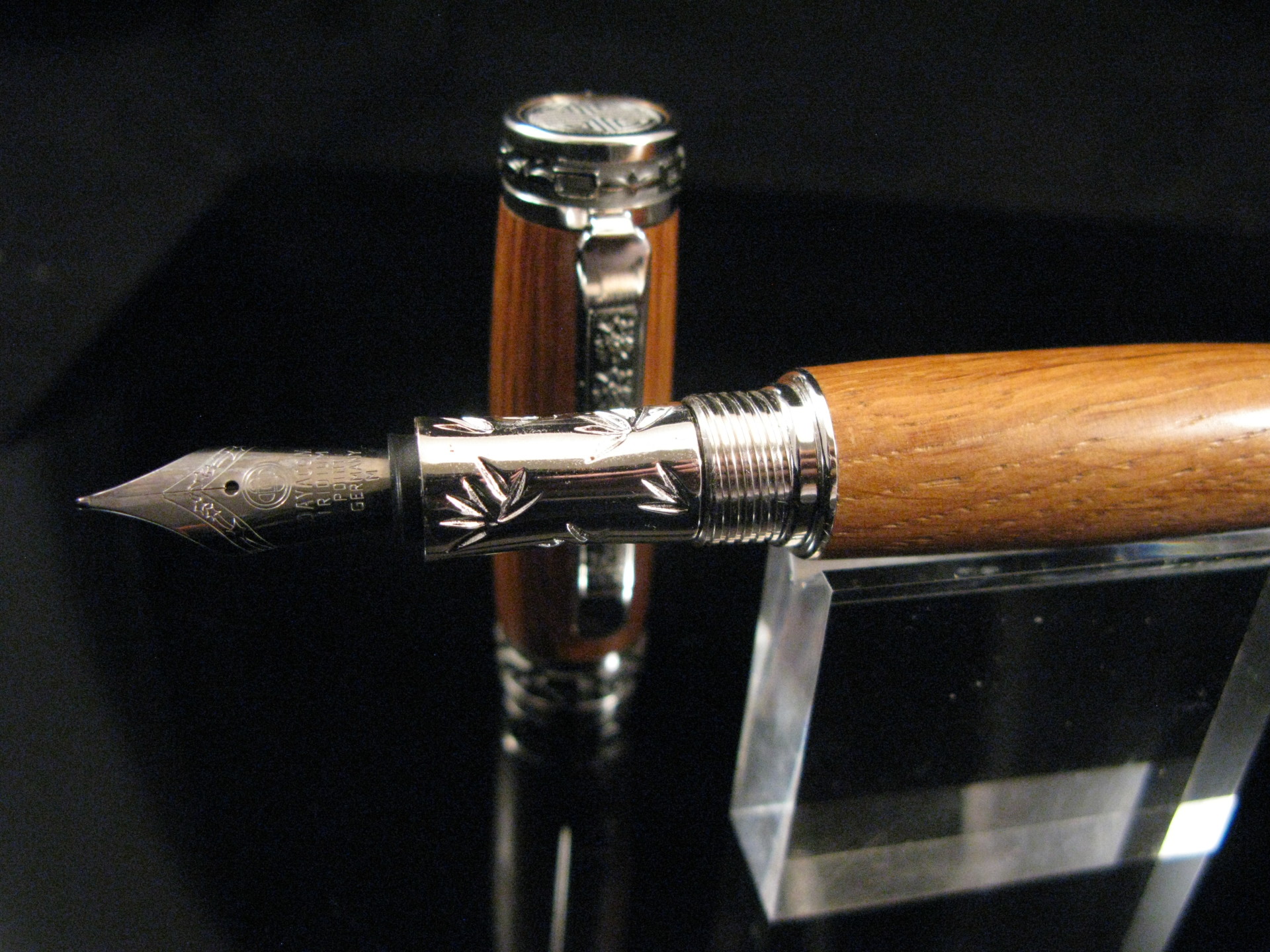Pen Care Tips
Pen Care Tips
The care and feeding of fountain pens
To ensure the proper functioning and long life of your fountain pen a basic knowledge of how the pen functions and what it requires you to do for proper care & maintenance is essential. Always consider the type of paper and ink you are using to help prevent clogging of the nib. Always properly clean the nib to maintain maximum performance levels of your Fountain pen.
Here's a link to an article about the history of fountain pens:
http://www.explainthatstuff.com/how-fountain-pens-work.html
To understand more about your Fountain pen it is important to learn how the mechanics of the pen work. Ink travels from the internal ink reservoir (either a cartridge or a converter) through a narrow groove called the feed. The feed directs the ink down to the tip of the nib. When the nib touches a paper surface the ink is drawn onto the paper by capillary action. The ink will continue to flow through the tines of the nib as long as the tip is in contact with the paper. The vent hole allows air to travel back into the ink reservoir and capillary action and gravity do the majority of the work to keep the ink flowing.
This problem is called skipping, and it is the result of an uneven flow of ink to the tip of the pen.
The Three Causes of Skipping
Of all of the issues a fountain pen can have, skipping can be the most difficult problem to diagnose. There are three common causes of skipping. The most common cause in a new pen are leftover oils and grit from the manufacturing process in the nib feed. The second cause of skipping is the ink itself. In pens that are filled with a boutique ink, skipping can be triggered by an ink with poor flow. Poor flow inks may have agents that clog a nib, or that dries too quickly when the pen is uncapped. Levenger inks often dry on the nib and have a finicky flow.
The last cause of skipping is often the hardest to fix: the nib itself is defective. Defective nibs are ones with improperly ground tips, or misaligned tines. Improperly ground nibs are nibs whose tips are too round to apply the ink consistently to paper. Nibs that are improperly aligned have their tines out-of-plane with each other; that is to say, the two halves of the nib do not touch and cannot evenly apply ink to the surface of the paper.
Cleaning the Pen [Pelikan Fountain Pen]
The best way to deal with fountain pen skipping is to start small. Since a clogged feed is the most common cause of new pen skipping, I recommend flushing all new fountain pens before using them for the first time.
Flushing is a simple cleaning technique. Unscrew the nib from the fountain pen body. If you have already attached a cartridge or converter, remove the ink. Using a very diluted dot of dish soap, gently run water through the collector (the tube that sticks out into the cartridge). Allow the water to flow through the nib tip for a minute or two. Make sure to use a very low flow of water, so as not to damage the internal parts of the ink feed. Allow the nib to dry for at least a half-hour. Wipe the nib with a cloth (not a tissue or paper towel, whose cotton fibers could catch in the nib). Attach the cartridge/converter. Work the ink through the nib feed by holding it as though you are going to write. To confirm that the ink is reaching the nib, dab the breather hole against a paper towel (the breather hole is the round circle on the nib). Do not dab the tip against a paper towel. Catching fibers from a paper towel in the tip can worsen your skipping problem!
If the first flushing did not work, attempt a second flushing with ink. To flush a pen with ink, fill a converter or cartridge and attach it to the collector. Squeeze the cartridge gently with your fingers. Wait for the ink to work itself through the feed. It should run down the nib. Dab this excess ink on a paper towel (using the breather hole) or on blotting paper if you have any on hand.
If the pen is a piston filler or vacuum filler, research the filling system before you start with an ink flushing. Piston fillers are uncommon, and vacuum fillers are rare, but they are still available on the market. The Pelikan M205 is a piston-filler. Piston fillers and vacuum fillers both draw ink into their reservoirs using the pen nib. To flush either of these pens, you may only need to fill and blot the pens rather than do a full fill & flush.
Some pen enthusiasts swear by ultrasonic cleaners to keep their nib feeds squeaky clean. Ultrasonic cleaners start in the $80 range. Personally, I have never had cause to purchase one in my years of pen collecting. However, if recurrent clogs are a problem with your nib feed and the thought of flushing nibs wearies you, an ultrasonic cleaner might help ease the pain of weekly, or even daily, nib flushings.
Advanced Pen Care
If the pen still skips after a couple rounds of water and ink flushings, and a more flow-friendly ink hasn’t helped, you may consider trying more advanced techniques. Unlike cleaning, which is basic maintenance any pen owner should be able to perform, these solutions require a fair bit of confidence on the part of the owner.
Advanced pen care requires specialized equipment. The two tools you will need are a jeweler’s loupe (to see the pen nib under magnification) and 12,000 grit sandpaper. It is imperative that you purchase a high-grit sandpaper, because lower grit papers will damage the nib. Examine the nib using the jeweler’s loupe. Are there any strange burrs on the area where the two tines meet? Are the two tines level with each other so that ink can flow evenly to the tip? How rounded is the tip of the nib?
New pens that skip often have pen tips are are too rounded. A tip that is too round is called an improperly ground nib. To remedy an improperly ground nib, you will need to grind the nib against 12,000 grit sandpaper to create a flat surface where the ink can contact the paper.
[cross c-series fountain pen nib] To grind the nib, lay the sandpaper down on a writing surface. Make sure the pen is empty of ink (flushing it before starting the grinding process is highly recommended). Now it’s time to do some writing exercises on the sandpaper. Make small circles clockwise on the sandpaper. Do this for a minute. Now counter-clockwise circles. Next, draw diagonal slashes moving from left to right, and then right to left. Make forward slashes (low to high) and backslashes (high to low). Finally, make small circles that gradually change into larger, wider circles each time you move the pen across the sandpaper.
The idea behind these exercises is to grind the nib in multiple directions. When you use a pen, the nib contacts the paper in a variety of angles. These angles change depending on how you hold the pen, or how you turn the nib when you follow through a letter. The grinding process should attempt to recreate these different angles and strokes.
After a session of 5 or 10 minutes, the pen should contact paper more smoothly. However, each nib requires a different amount of grinding. It may take a few grinding sessions to finish your particular nib properly.
When To Take Your Pen to a Nibmeister
If the problem with the nib cannot be solved by grinding, or advanced care techniques seem daunting for a first-time fountain pen owner, it may be time to seek the services of a professional. A nibmeister is a professional who has been trained in grinding, smoothing, flexing, and cutting nibs. Nibmeisters can fix misaligned tines, improperly ground nibs, or tune nibs to flow better with their feeds. Nibmeisters can be difficult to find in your local area; normally you will need to seek one out on the internet. One of the easiest ways to find one is to search for reviews on pen message boards.
Seeking the services of a nibmeister is the solution of choice if your pen has an expensive nib. As much as you may want to learn the ropes of fountain pen repair, with a several hundred-dollar gold nib, it’s better to let a professional apply the proper care to the nib than risk damaging it with amateur repairs.
If the pen that’s giving you problems is fairly inexpensive, using a nibmeister might seem like overkill. When my Cross C-Series fountain pen developed a skipping problem from a misaligned tine, I decided that it was a more cost-effective solution to purchase a new nib assembly from Cross for $60 rather than seek out the services of a professional.
You will need to judge how bad the problem is, and if the skipping issues are within your power to solve. Cleaning, or substituting an ink with a good flow for your current ink, will often do the trick. If it doesn’t, then you know it’s likely time to seek more advanced remedies for your nib.

None of us can have as many virtues as the fountain pen, or half it's cussedness; but we can try.
Mark Twain
